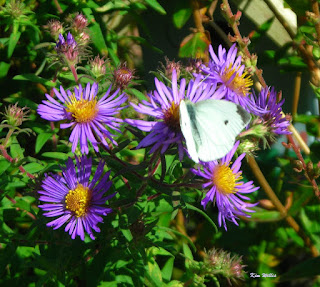 |
| Native asters provide fall food for pollinators |
Asters are
fall blooming perennials that can add last minute color to flower beds and
borders. Perennial asters are easier to
grow than mums are and more likely to survive the winter even when planted in
full bloom in the fall. There are dozens
of varieties of asters and there is sure to be a color and form of aster that
will suit any garden.
Aster comes
from the Greek word for star, and our wild asters may seem as numerous as stars
sparkling across a dry meadow in the fall. Native asters are often tall; they have
struggled up through tall grass and weeds to the sunlight. They throw their froth of small daisy like
flowers out above the brush and sprinkle them through the weeds. Many cultivated asters have been developed
from the natives that are more compact, have a mounding habit and larger
flowers.
Native
aster species are wonderful for naturalized gardens and attract butterflies and
bees and people sometimes move native asters to flower borders and butterfly
gardens. (Take only plants from your own property or from areas where you have
permission to dig the plants.) Individual native plants have different growth
habits so choose carefully. It might be
best to choose the plant in the fall when it is in bloom, mark the plant, and
return in the spring to transplant it, as wild asters seem to establish better
when moved in the spring.
Compact varieties of asters are excellent for
fall containers. Some asters can be used
as ground covers. Asters make good, long
lasting cut flowers and also dry well.
Growing asters
Almost all
asters are upright plants with thick woody stems and long narrow leaves. There
are some that hug the ground and one that is a climbing vine. Aster flowers are small, 1-2 inches across,
and daisy like. They come in all shades
of blue, purple, white, pink and red.
While the centers are often yellow, there are no yellow or orange
perennial asters yet. Asters begin blooming in late summer and usually continue
blooming until a hard freeze kills them.
Perennial
asters are hardy from zone 3-9. Asters
tolerate a wide range of soils. They
will do well in dry areas but will also do fine in well-watered sites. Most asters prefer full sun; some will
tolerate light shade. Unless your soil
is extremely poor, native species of asters do not need fertilization. Some of the cultivated varieties may bloom
heavier if they are fertilized in the early spring with a timed-release
fertilizer for flowers.
 |
| ‘Alma Potschke’ |
You can
start asters from seed but most gardeners will want to start with plants. Potted asters can be planted in the garden
from early spring to about 6 weeks before the ground freezes. If you start with seeds you can sow the seed
where you want the plants to grow or for best results, you can start the seed
indoors 6-8 weeks before your last frost and transplant outside.
Space
asters from 1 to 3 foot apart, depending on the variety. Asters form large clumps and need to be
divided every 3 years or so. Simply dig
up the clump in the early spring and separate it into 2 or 3 parts, which you
can then re- plant.
If you want
dense rounded clumps of asters and abundant flowers, pinch your aster plant
back by about 6 inches at the beginning of July. Take your fingers and “pinch” the stem off
just before a set of leaves. Don’t pinch
asters after July 15. If you don’t
pinch your asters they will be taller and the display will be airy and
lighter. In the fall after a hard freeze
has killed the plants, asters may be cut off to ground level.
Asters are
prone to powdery mildew, a fungus disease that makes the leaves first get a
white, powdery coating, then turn brown and fall off. You can use a flower fungicide to prevent the
disease, applying it from about July 1 through the blooming season. Provide good ventilation by not crowding the
plants and don’t keep asters overly moist.
Some aster varieties
The native
New England Aster has lovely blue-purple flowers and cultivated varieties of
this native include ‘Purple Dome’ - deeper purple flowers on a rounded, compact
plant, and ‘Alma Potschke’ - rosy pink flowers.
‘White Wood
Aster’ is a native species that has loads of tiny white flowers with purple
centers. It will tolerate light shade. ‘Silky Aster’ is a native that has silvery
gray leaves and rose-violet flowers.
 |
| White Heath aster, a common wildflower |
Other
cultivated asters include ‘Lady in Black’ which has deep purple foliage and
hundred of tiny white daisies with pink centers. ‘Wonder of Staffa’ has
lavender flowers that begin in late June and keep blooming until frost. ‘Pink Star’ is a 2 foot mounded aster smothered
with small, soft pink flowers.
Odd asters
include the native climbing aster, Carolina
Asters are great plants for fall color in the
garden and since they survive dry conditions well are great for areas where
water use is restricted. They provide
food for butterflies and bees when little else is available. They deserve to be planted in the garden much
more frequently than they are.
 |
| Stiff Asters, another wildflower. |
This comment has been removed by a blog administrator.
ReplyDelete